You might recall the image of a Victorian gentleman caught in a sudden downpour, his stylish raincoat draping elegantly over his shoulders. The journey of this practical garment stretches far beyond that era, revealing a fascinating evolution influenced by necessity and innovation. From ancient waterproofing methods to modern fabrics that blend style with function, the raincoat's story is as varied as the weather itself. What drove these transformations, and how did they shape our contemporary experience with this essential piece of outerwear?
Early Waterproofing Techniques
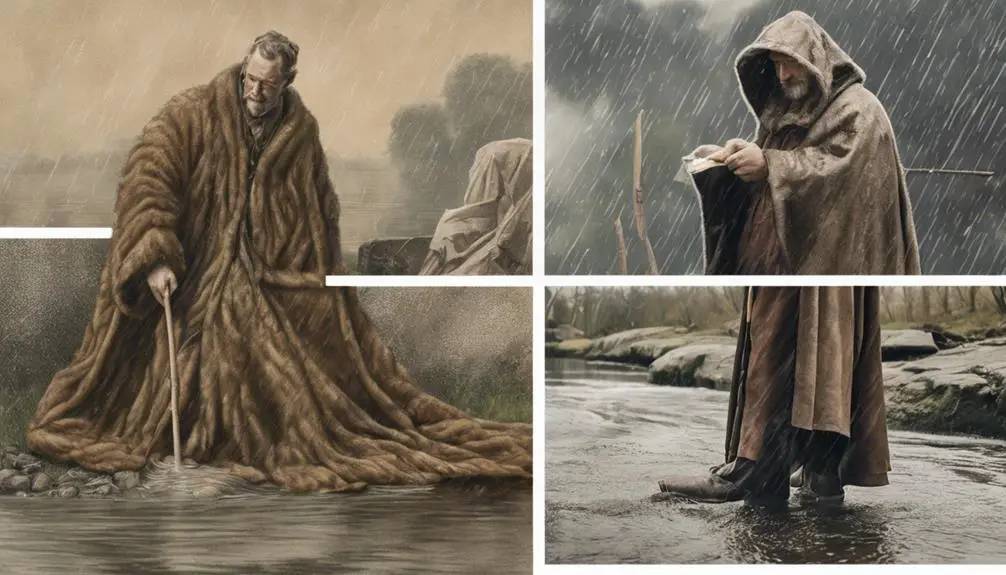
Throughout history, humans have sought effective ways to stay dry, leading to innovative waterproofing techniques. Can you imagine cavemen trying to dodge raindrops? Stone Age folks figured out pretty quickly that animal fur worked wonders for protection from the rain. They used its natural water-resistant properties to keep themselves cozy and dry. Fast forward a bit, and the Inca Indians were soaking their clothing in sap from rubber plants. Talk about creativity!
Then you've got the Inuit and Viking cultures, who took things up a notch by soaking their fabrics in fish oil. Yes, fish oil! It created a natural barrier against moisture, and hey, it worked. Meanwhile, Saxons were rubbing animal fat on sackcloth to minimize water absorption. Who knew that smearing fat could lead to such clever rain clothing?
These early waterproofing techniques show just how resourceful humans can be when it comes to staying dry. Isn't it fascinating how various civilizations, from the Inca to the Vikings, independently developed methods to create waterproof fabric? It's like they all felt the need to dodge the rain, no matter where they were in the world.
The First Modern Raincoat
After centuries of relying on various materials for rain protection, the evolution of waterproof clothing took a significant turn with the invention of the modern raincoat. Enter Scottish chemist Charles Macintosh, who patented the first modern waterproof raincoat in 1824. His genius idea? He created a fabric by sandwiching rubber between layers of cloth. This innovative material, known as India rubber cloth, aimed to keep you dry while being much more comfortable than those old, heavy waterproof garments.
Macintosh's design was a game-changer! Before this, most waterproofing methods were pretty ineffective and downright uncomfortable. Ever tried wearing a raincoat that felt like a plastic bag? Not fun! But Macintosh's coat offered a solution. It became a stylish go-to for staying dry, complete with a chic tartan lining that made it look good too. Sure, people were worried about the nonporous rubber causing sweat issues, but who could resist that level of creativity?
To make things even better, George Spill came along and added metal eyelets under the armpits for ventilation. Can you imagine sweating it out in the rain without proper airflow? That's a recipe for disaster! Thanks to these improvements, the modern raincoat is both functional and fashionable, proving that you don't have to sacrifice comfort for style. So next time you slip on your raincoat, remember the brilliant minds that made it possible!
Iconic Designs and Features
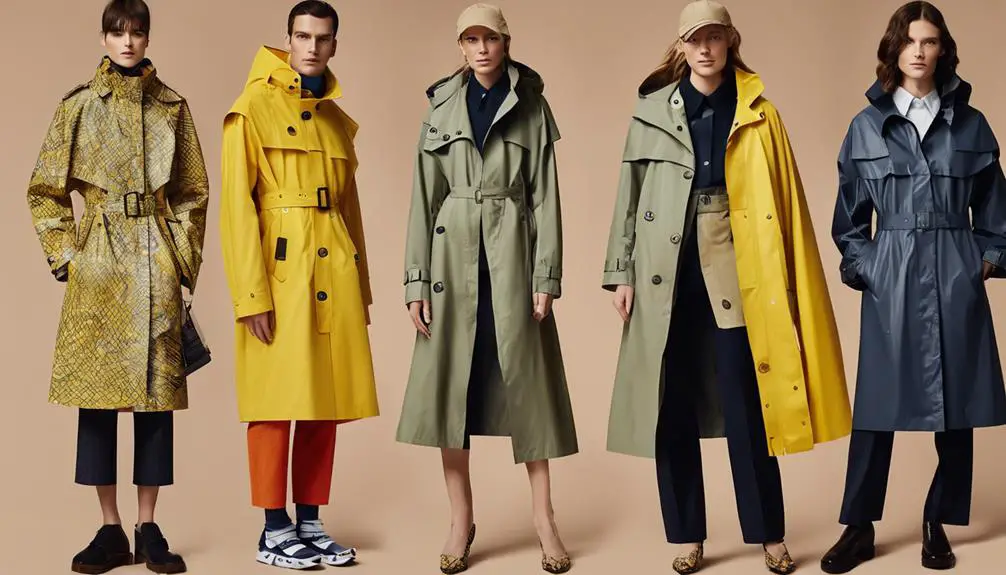
The iconic designs and features of raincoats have evolved remarkably since their inception. Think about it: who doesn't love a good raincoat? In the 19th century, Charles Macintosh made waves with his tartan-lined rubber cloth coat, which became a standard for waterproof outerwear. This design set the stage for the raincoats that are recognized today.
Ever heard of George Spill? He introduced metal eyelets under the armpits of Macintosh's design, which helped with ventilation. No more sweaty armpits! This clever feature is still found in many modern raincoats. Early designs were long and loose, with high roll collars and large pockets for practicality and style. You could stash your essentials without getting soaked!
Fast forward to the 1920s, when hoods and matching rain hats became all the rage. Then, in the 1960s, high-visibility colors were introduced for those working outdoors—because safety is key, right?
Today, raincoats offer even more with technical advancements. Materials like Gore-Tex and DWR-coated nylon let moisture escape, keeping you dry while protecting you from the rain. Isn't that amazing?
Industrial Revolution Innovations
Innovation during the Industrial Revolution transformed raincoat manufacturing, paving the way for modern waterproof fabrics. Imagine a time when the only way to stay dry was to huddle under a tree or rush indoors! Thanks to this era, you can now don a stylish raincoat without worry. It all began with Charles Macintosh, who created a solvent for rubber back in 1816. By 1823, he patented a process that glued two layers of woolen cloth together, giving birth to the first waterproof fabric. This innovation was significant, as it set the stage for future advancements in protective clothing, similar to the evolution seen in vintage tag identification. Sure, it was stiff, smelled like rubber, and leaked at the seams, but hey, it was a start!
As you imagine those early raincoats, picture the collaboration between Macintosh and Thomas Hancock. Their teamwork led to the groundbreaking vulcanization process, which made rubber more durable and flexible. This was a game-changer for waterproof clothing! By the mid-19th century, advancements in maritime textiles influenced raincoat design. Sailors switched from heavy flax sails to lighter cotton sails, and guess what? That inspired lighter, more functional raincoats for everyone.
Military Developments in Rainwear
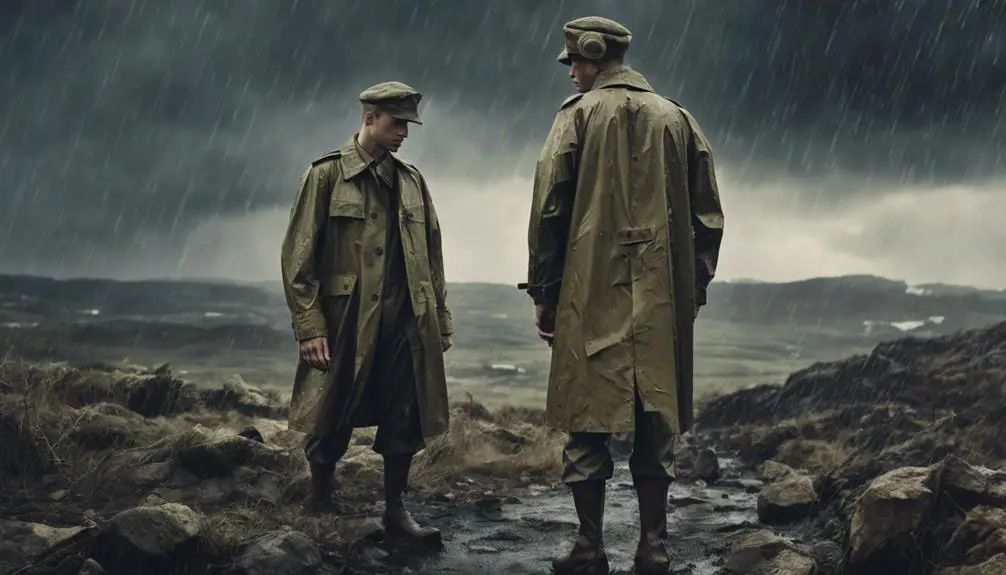
Wartime demands during the late 19th and early 20th centuries revolutionized rainwear, pushing manufacturers to develop functional and durable options for soldiers. Can you imagine trudging through mud and rain without a decent raincoat? Thankfully, innovators stepped up to the challenge. One major player was Thomas Burberry, who patented gabardine in 1879. This waterproof fabric became a game changer, offering soldiers comfort and durability in the field. Burberry's commitment to creating high-quality fabrics and innovative designs laid the groundwork for modern rainwear, as seen in the evolution of vintage Burberry items.
Gabardine's unique diagonal twill design allowed water to flow right down, keeping soldiers dry while they carried out their missions. The British military quickly adopted trench coats made from gabardine during World War I, making them a regulation issue. Suddenly, these stylish yet practical raincoats were everywhere, and they became iconic both in and out of the battlefield.
The urgent need for effective rainwear during military campaigns spurred significant military developments. These advancements didn't just help soldiers; they influenced the entire rainwear market. Manufacturers realized that if they could keep soldiers dry in the harshest conditions, civilians would want the same. So, when you see a sleek raincoat today, remember the brave soldiers who paved the way for those waterproof fabrics.
Now, next time it pours, you'll appreciate your rainwear a little more, knowing it has a rich history rooted in military innovation. So, are you ready to face the rain? Grab your coat and go!
Modern Fabric Advancements
Modern raincoats are way cooler than you might think! With breathable materials like Gore-Tex, which was innovated in the late 1960s, and advanced waterproof coatings, you can stay dry without feeling like you're stuck in a sauna. This revolutionary fabric technology has evolved over the years, maintaining its reputation for quality and performance, as evidenced by its history and evolution. Plus, lightweight fabrics make it super easy to toss your raincoat in your bag—who doesn't love a stylish solution that's also practical?
Breathable Material Innovations
Revolutionizing the way we experience rainwear, breathable materials have become a game-changer in the design of raincoats. Imagine this: you're hiking in the rain, feeling cozy and dry, thanks to innovative fabrics like Gore-Tex. These breathable materials let your sweat escape while keeping the rain out—talk about comfort!
But that's not all. The development of Durable Water Repellent (DWR) coatings on nylon and polyester means your rainwear is super versatile. You get the best of both worlds: waterproof materials that still let you breathe. Plus, those lightweight micro yarns are a marvel! They provide water resistance without weighing you down, perfect for all you outdoor enthusiasts out there.
And let's not forget about climate control features. These awesome designs help keep your temperature just right, so you can tackle any weather condition without breaking a sweat—literally! With all these advancements, raincoats aren't just practical; they're colorful and stylish too! So, why settle for boring when you can rock a raincoat that's as functional as it is fun? Embrace the rain with breathable materials, and you might just enjoy getting wet!
Waterproof Coating Technologies
Today's raincoat technology is all about advanced waterproof coating technologies that elevate your outdoor experience. You want to stay dry, right? Well, modern fabrics make that easier than ever! With breathable materials like Gore-Tex, moisture vapor escapes while keeping water out. Say goodbye to feeling like you're in a sauna when it rains!
Here are a few key features you'll love:
- Durable Water Repellent (DWR) Coatings: These create a water-resistant surface, causing rain to bead up and roll off your jacket.
- Lightweight Synthetic Materials: Fabrics like nylon and polyester are quick-drying, mildew-resistant, and tough against abrasion. Perfect for your adventures!
- Micro Yarns: These provide an awesome balance of water resistance and breathability, making your raincoat comfy for whatever you're up to.
And let's not forget innovative treatments, like cupro-ammonia, which make the fabric soft and colorful while keeping it waterproof. Who knew staying dry could look so good? With these amazing advancements, you can embrace the rain with confidence. So, grab your raincoat and get outside!
Lightweight Fabric Development
Advancements in lightweight fabric development have transformed the way we approach rainwear. Remember those heavy, bulky raincoats? Well, say goodbye to those! With the introduction of paraffin wax-treated cotton in the 1930s, rainwear got a serious upgrade. It became water-resistant while still keeping it light. Then, in the 1940s, synthetic materials like Nylon came onto the scene. These provided not just lightweight options, but also durability and quick-drying capabilities. Pretty cool, right?
Fast forward to the 1960s, and PVC made a splash. It offered a cost-effective, waterproof solution that didn't weigh you down. But the fun doesn't stop there! Today, modern fabrics focus on breathability too. Ever heard of Gore-Tex? It's a game-changer, letting moisture escape while keeping rain out, which means you can stay comfy even in a downpour.
Current designs use lightweight micro yarns and DWR coatings, pushing the boundaries of what waterproof raincoats can be. So, next time you put on your raincoat, think about all those incredible advancements. Who knew staying dry could be so stylish and lightweight?
Global Variations in Rainwear
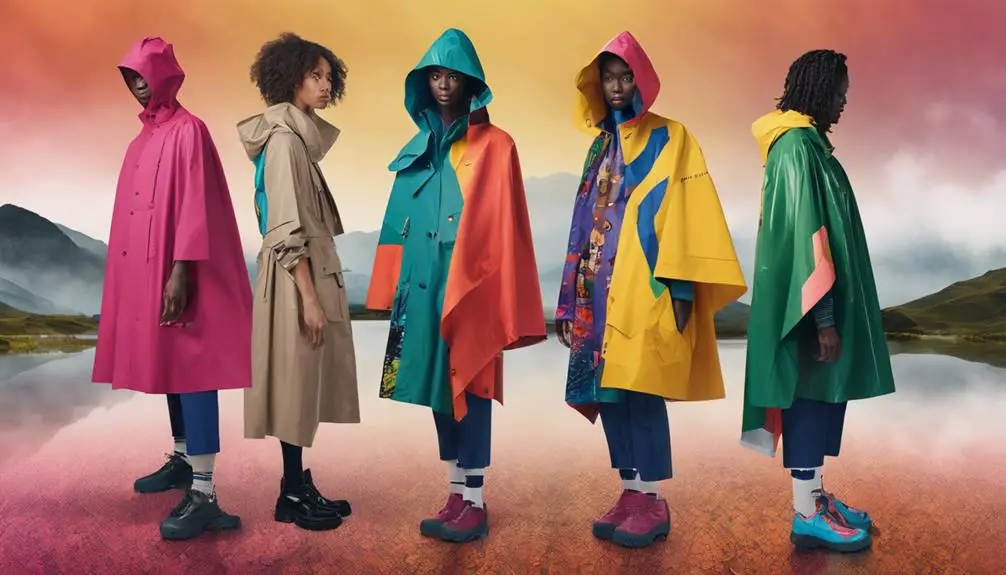
Rainwear traditions around the world showcase a fascinating array of materials and techniques tailored to regional climates and cultural practices. When you think about rainwear, you might picture a simple raincoat, but there's so much more! Different cultures have unique ways of staying dry, often using local resources.
For example, did you know that Mexican indigenous people created rain capes called capotes de plumas? They made these beautiful pieces from feathers, giving them a stylish yet water-resistant design. Over in New Zealand, you'd find pākē or hieke, crafted from flax fibers, perfectly suited for those rainy days. And in ancient East Asia, people took days to weave raincoats from water-repellent plant fibers like rice straw, often adding camouflage features—how cool is that?
Here are a few more interesting rainwear traditions:
- Polynesian Hawaiians crafted Kui lai or Ahu Lai using Ti plant leaves, showing off their resourcefulness.
- The indigenous peoples of the Northwest Pacific Coast relied on woven cedar fibers for waterproof clothing.
- Mexico's traditional rain capes even show Filipino influences, highlighting how cultures exchange ideas and styles.
Isn't it amazing how rainwear reflects the creativity and adaptability of different cultures? Next time you grab your umbrella, think about the rich history behind rain protection. You might just feel a little more connected to people all over the world, braving the rain in their unique ways!
Frequently Asked Questions
Who Invented the First Raincoat?
You'll find that Charles Macintosh invented the first raincoat, utilizing waterproof materials in his early designs. His work holds historical significance, paving the way for modern rainwear and transforming how we approach weather-resistant clothing.
What Does the Raincoat Symbolize?
Did you know that over 60% of people consider raincoats essential? They symbolize style evolution, cultural significance, and practical utility, showcasing humanity's resilience and ability to adapt while balancing fashion and functionality in wet weather.
What Did People Use Before Raincoats?
Before raincoats, you'd find ancient waterproofing techniques like animal fat on sackcloth or fabrics for wet weather soaked in fish oil. Early rain gear included capes made of straw, showcasing innovative approaches to staying dry.
Why Do We Wear Raincoat When We Go Out in the Rain?
When you step into the rain, a raincoat's like a superhero cape! You enjoy functionality benefits, thanks to material advancements that keep you dry, while also embracing its cultural significance in fashion and practicality.
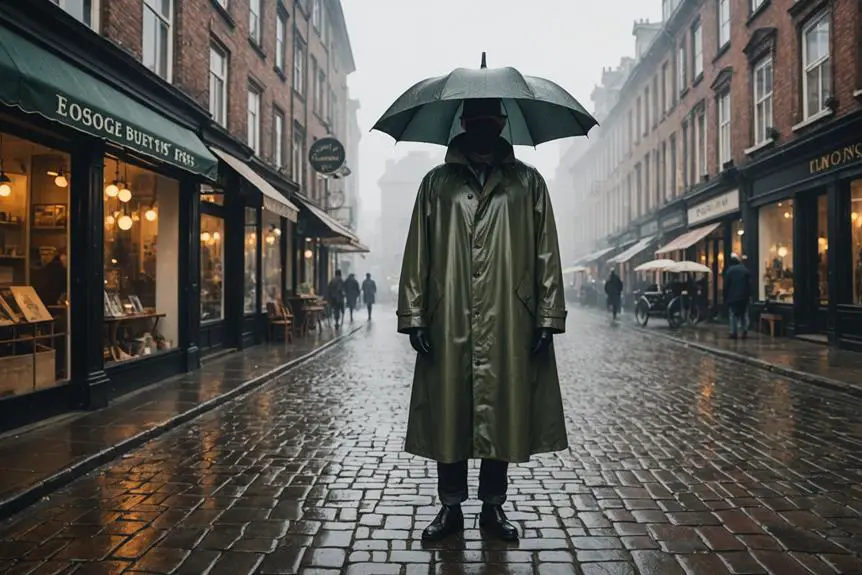

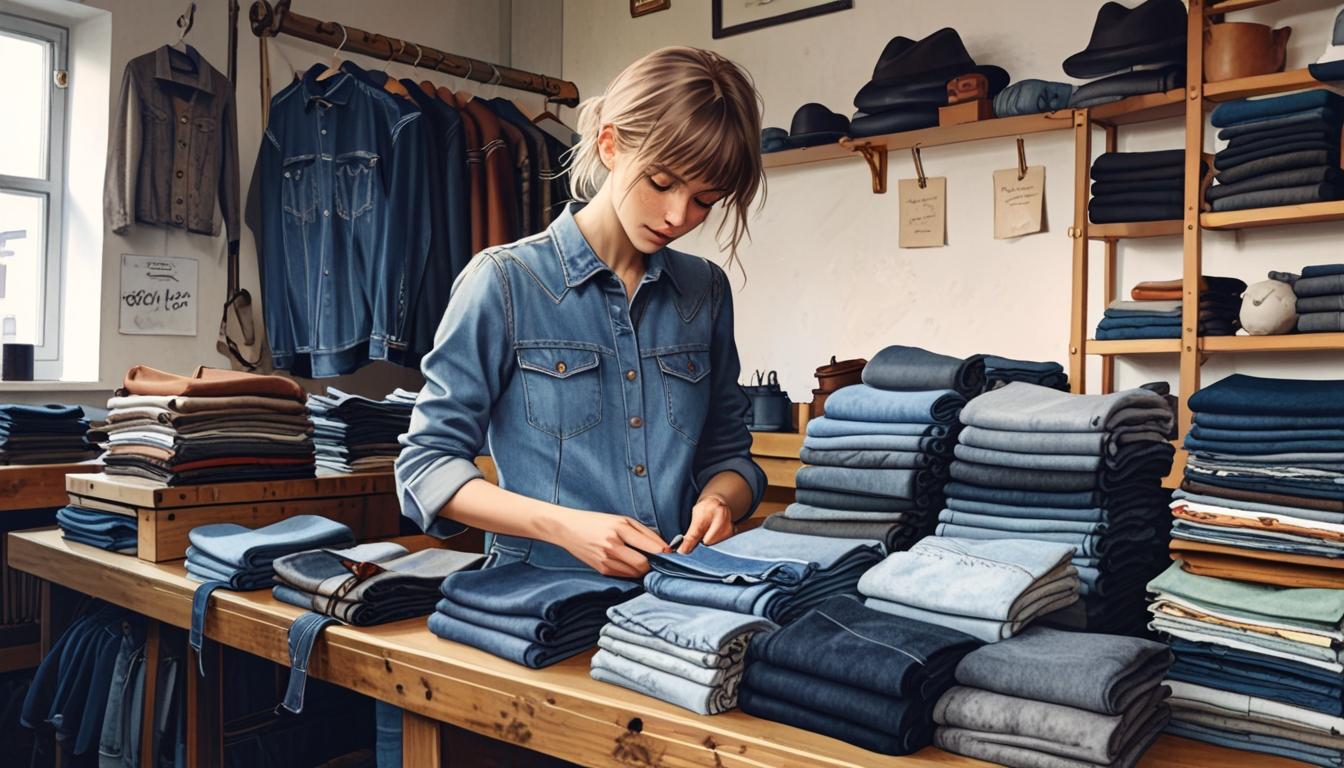


One Comment